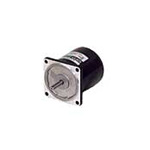(!)NOTE : Windows 7 users won’t be able to use some latest features of eCatalog/WOS since Microsoft is ending support for Windows 7 on 14 Jan, 2020. Please upgrade your system for uninterrupted services.
- Notice of End of Sales for Economy Series Pneumatic Equipment Category. More information.
Small AC Motors(Motor Type:Reaction Synchronous)
Brand |
|
|---|---|
| CAD |
|
| Days to Ship |
|
1 items
- Sort By
-
You can add up to 6 items per a category to the compare list.

Reaction Synchronous Motor K Series
ORIENTAL MOTOR
A reaction synchronous motor is a motor that rotates at a rotation speed that is synchronized with the power supply frequency. Single-direction continuous operation, and is appropriate for when a fixed rotation speed is desired even if the load fluctuates.
Type Motor Type Rated Output(W) Square Flange Dim. A(mm) Power Supply Reduction Ratio Gear Head Type Electromagnetic Brakes, Clutches Environment Voltage(V) Motor Only Reaction Synchronous 3 ~ 25 60 ~ 90 Single-Phase - - Not Provided Standard 100 ~ 115 From: ₹ 7,831.20 Days to Ship: 27 Day(s) or more  27 Day(s) or more
27 Day(s) or more
| Brand |
|---|
| Product Series |
| From |
| Days to Ship |
| Type |
| Motor Type |
| Rated Output(W) |
| Square Flange Dim. A(mm) |
| Power Supply |
| Reduction Ratio |
| Gear Head Type |
| Electromagnetic Brakes, Clutches |
| Environment |
| Voltage(V) |
You can add up to 6 items per a category to the compare list. | |
| Brand | ORIENTAL MOTOR |
| Product Series | |
| From | ₹ 7,831.20 |
| Days to Ship | 27 Day(s) or more |
| Type | Motor Only |
| Motor Type | Reaction Synchronous |
| Rated Output(W) | 3 ~ 25 |
| Square Flange Dim. A(mm) | 60 ~ 90 |
| Power Supply | Single-Phase |
| Reduction Ratio | - |
| Gear Head Type | - |
| Electromagnetic Brakes, Clutches | Not Provided |
| Environment | Standard |
| Voltage(V) | 100 ~ 115 |
Loading...
Configure
Specification/Dimensions
-
Type
- Gear Head Only
- Motor Only
- Others
- Set
- Controller Only
- Motor group
-
Motor Type
-
Rated Output(W)
-
Square Flange Dim. A(mm)
-
Power Supply
-
Reduction Ratio
-
Gear Head Type
- Not Provided
- Parallel Shaft
- Perpendicular Shaft
- Linear
-
Electromagnetic Brakes, Clutches
- Not Provided
- Electromagnetic Brakes
- Clutch
-
Environment
-
Voltage(V)
Related Categories to Small AC Motors
FAQ AC Motors
- Question: How does the working principle of a 3-phase induction motor differ from that of a single-phase induction motor?
- Answer: The key difference between these two types of motors lies in the power supply they require. A single-phase induction motor operates on a single alternating current (AC) voltage source, while a 3-phase induction motor requires three separate AC voltage sources with a phase difference of 120 degrees between them. This difference in power supply affects the motor's starting torque, efficiency, and overall performance. 3-phase motors typically provide smoother and more reliable operation, making them suitable for industrial applications, whereas single-phase motors are often used in smaller appliances and machines.
- Question: Between the induction motor and the DC motor, which one is more suitable for variable-speed applications and why?
- Answer: DC motors are generally more suitable for variable-speed applications because their speed can be easily controlled by adjusting the voltage supplied to them. This feature allows precise speed regulation, making DC motors ideal for applications like robotics and conveyor systems. On the other hand, induction motors, especially single-phase ones, are typically less suited for variable-speed control, as their speed is primarily determined by the frequency of the AC power supply.
- Question: How do gear heads contribute to the performance of motors?
- Answer: Gear heads, also known as gearboxes, are often used in conjunction with motors to achieve specific speed and torque requirements. They allow motors to transmit power more efficiently by matching the motor's speed and torque characteristics to the needs of the application. Gear heads can increase output torque, reduce speed, and enhance precision in various automation processes.
- Question: Are there motors with adjustable speed or direction?
- Answer: There are motors designed with adjustable speed and direction control. These motors often incorporate electronic speed controllers (ESCs) or variable frequency drives (VFDs) that allow for precise adjustment of motor speed and the ability to reverse direction. Such motors are commonly used in applications where flexibility and control are essential, such as in conveyor systems, robotics, and industrial machinery.
- Question: What are the typical applications of AC motors?
- Answer: AC motors find widespread use in various applications, including fans, pumps, compressors, conveyor systems, HVAC (heating, ventilation, and air conditioning) units, and industrial machinery. Their versatility, reliability, and ability to operate on AC power grids make them essential in many automation and industrial processes.





How can we improve?
How can we improve?
Thank you for your time.
Your feedback is essential for our continuous improvement
Privacy Policy
Thank you for your cooperation.
Thank you for your time.
Your feedback is essential for our continuous improvement
Please use the inquiry form.
Privacy Policy